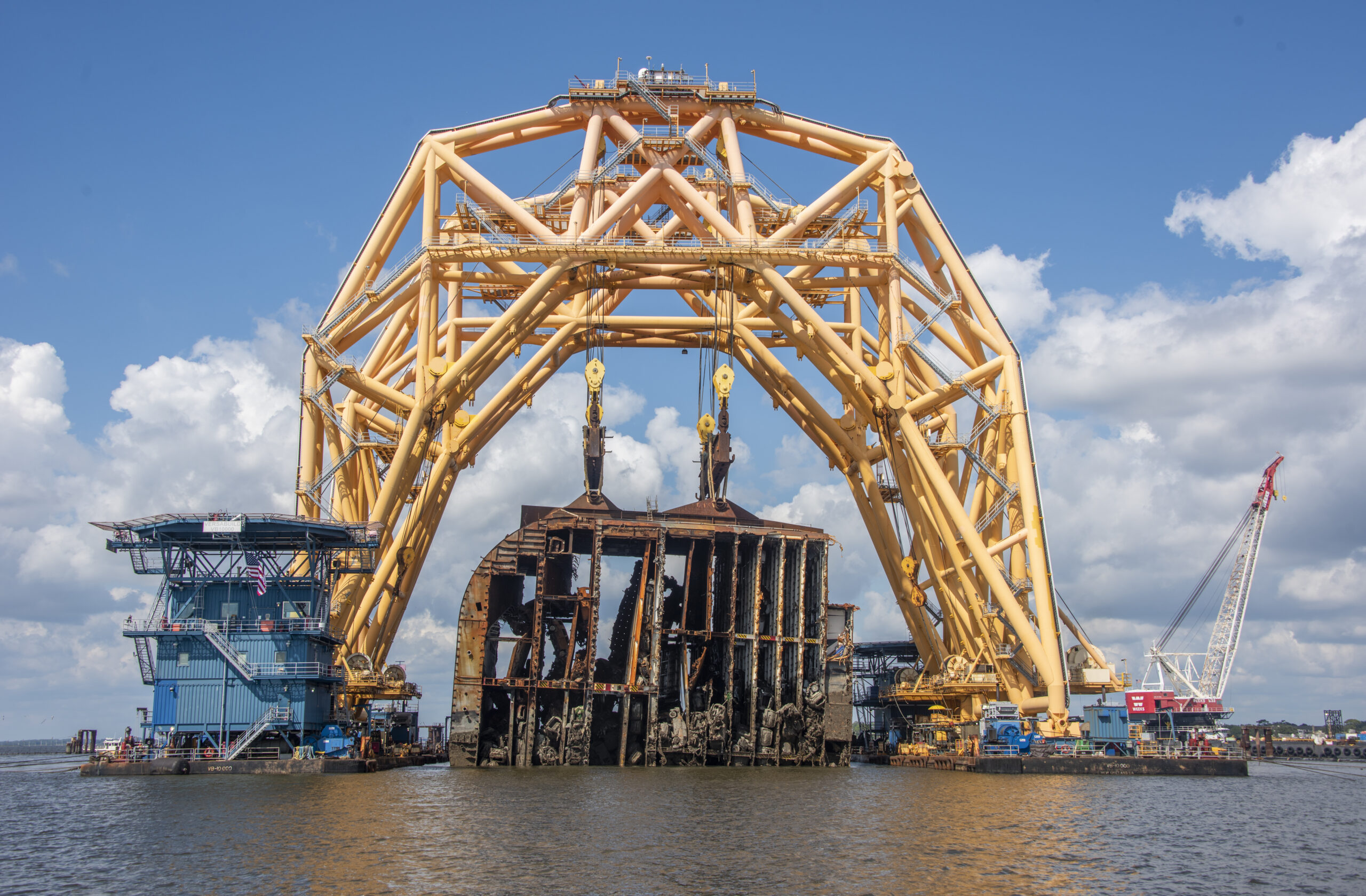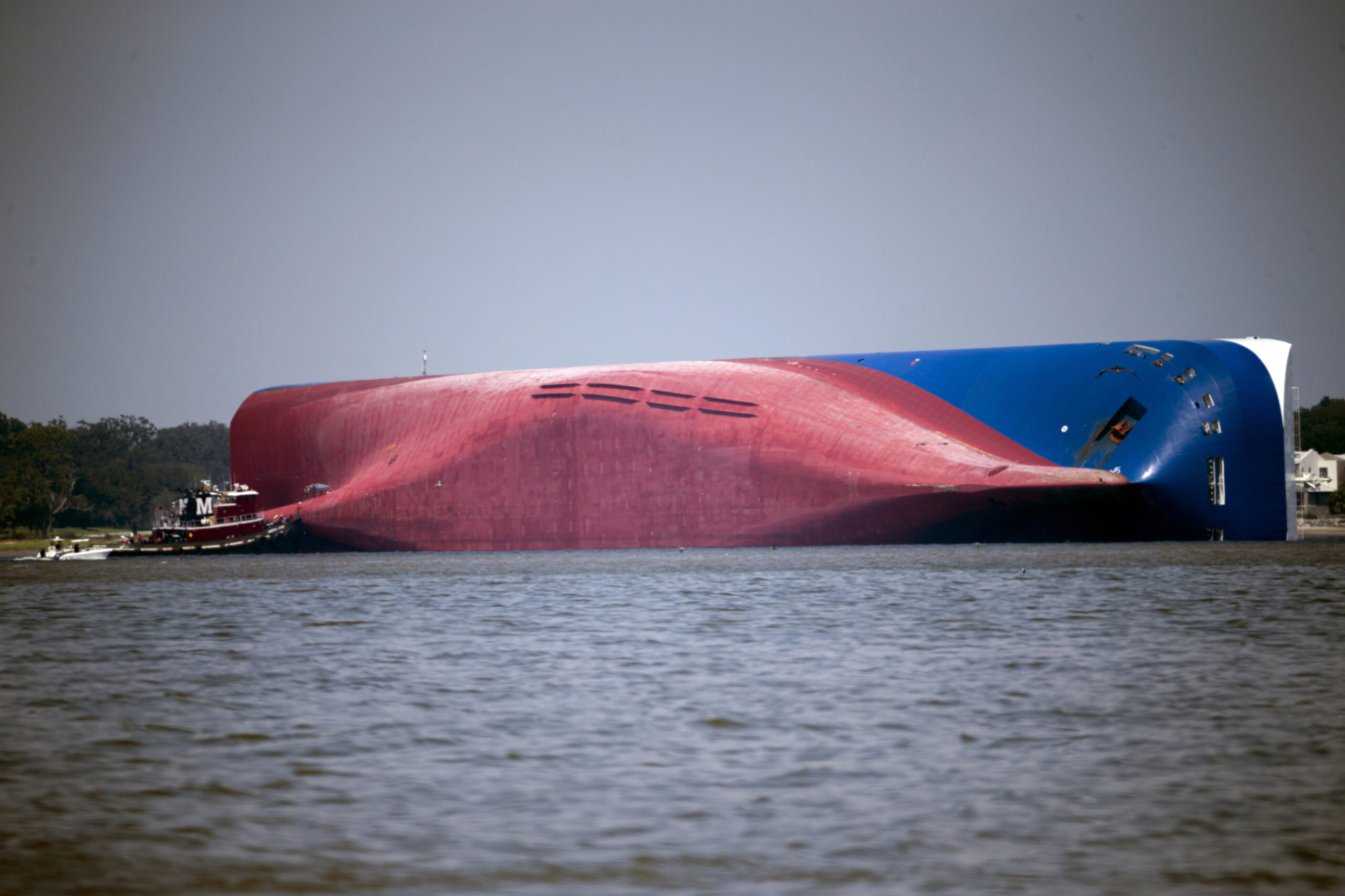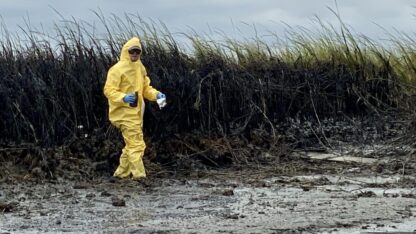More than two years after the cargo ship, the Golden Ray, capsized off the coast of Georgia, the effort to remove it is nearly complete.
The sheer size of the ship has complicated the operation. According to the Coast Guard, it’s the largest wreck removal in U.S. history, but that hasn’t been the only challenge. Tough environmental conditions and the pandemic have also added to the difficulty and caused delays.
The Golden Ray started to tilt dangerously just after leaving the Port of Brunswick in September 2019.
It ended up stuck on its side half underwater, right off the coast between St. Simons and Jekyll Islands, a hulking thing visible from the mainland, with more than 4,000 cars inside. Everyone on board escaped, though some crew members were trapped inside for more than a day before being rescued.
The National Transportation Safety Board eventually concluded that an officer’s error when calculating the ship’s stability likely led to the capsizing.
“There hasn’t been an incident like this in the U.S. before,” said Chris Graff, referring to the size of the ship.
Graff is the director of response services for Gallagher Marine Systems, representing the ship’s owner on the team handling the wreck response and removal. He was on a boat with other response officials on a windy gray day just before Thanksgiving, visiting the site of the wreck.
It was windy enough that the cranes that were dragging debris up from underwater weren’t in use, and the wreck area was relatively quiet.
“The weather is a big issue here,” Graff said. So are the strong currents and the surroundings – ecologically-rich salt marsh and a busy shipping lane.
The wreck weathered two hurricane seasons. It caught on fire. Oil leaked out.
And then there was the pandemic, which delayed equipment getting delivered and complicated keeping workers safe.
Now, more than a year after crews began sawing the ship into giant metal chunks to haul away, the Golden Ray and its thousands of cars are gone.
In early December, salvage teams finished scraping up the remaining debris and cars from inside an environmental protection barrier set up around the wreck area. Now they’re taking the barrier itself apart.
From the village on St. Simons Island, there’s been a close-up view of the whole process. The ship had loomed near the fishing pier, surrounded by cranes and barges.
“First, it was an interesting spectacle to see,” said Lisa Roberts, who works at the Beach Bum Shell Shop. But the novelty wore off. “After a while, we were kind of tired of looking at it, honestly.”
She said they did get some extra business from the wreck, though: people coming out for a look at the ship would stop in and browse.
Other stores near the pier experienced the same.
There’s a shop selling a “ship happens” t-shirt with an image of the Golden Ray. A local brewery started making a Golden Ray IPA.
“We definitely got a lot of calls,” said Katie Huffmaster, who works at Golden Isles Realty, a company that manages vacation homes. “People would say, ‘Hey, I’m coming down, I really want to see the ship.’”
Huffmaster said at one point, soon after the Golden Ray capsized at a time of year when business would typically be winding down, all of their beach houses were occupied – not only by tourists, but also by people coming to work on the wreck, who needed places to stay.
But some people in the area, like Captain Rob Aldridge, a fishing guide, have been worried. He said he’d seen the oil in the water, and he’s wary of eating fish caught too close to the wreck.
“My biggest concern is not the last two years and change or any of that. It’s down the line,” Aldridge said while working on his boat at St. Simons Marina.
Sue Inman, the coastal advocate with the local environmental group, One Hundred Miles, shares that concern. The salt marsh in the area is important ecologically and commercially, she said.
“It’s a nursery,” she said. “We have our shrimp, and this is where they come in to lay their eggs. This is where redfish, which is one of our top sportfishes, come in and spawn.”
Inman was riding out to the wreck area on Andy Jones’s boat, the Minorcan Mullet.
Jones, an arborist on St. Simons and former radio announcer for a high school football team, had taken to documenting the Golden Ray removal process on YouTube; some of his videos have gotten hundreds of thousands of views.
The day he and Inman went out for a look, one of the cranes was in action, dragging a giant piece of metal up from the bottom. Jones said he thought it might be a piece of the ship’s deck and estimated it was 40 or 45 feet long.
“I don’t think that I will say I’m satisfied or happy or content with the process for four or five years – until we understand what kind of impact this has had locally,” he said. “There was so much debris. And it’s not that the oil happened this time and then this time. We were seeing continual sheen on the water.”
Another environmental group, Altamaha Riverkeeper, has been advocating for a Natural Resource Damage Assessment, a federal study that would take account of the harm done by the wreck. Officials say that’s not ruled out yet.
Last month, Georgia’s Environmental Protection Division proposed a $3 million fine for the company that owns the Golden Ray for violating state water pollution law.
Environmental protection has been a big part of the official response, though.
Graff said the total cost of the Golden Ray response and removal would ultimately be in the hundreds of millions of dollars, and environmental protection accounts for about half of it. (None of the costs will be incurred by the state or federal governments, those will fall on the Golden Ray’s insurer.)
“The bottom line is, nobody wants the oil in the water,” he said. “We don’t want to impact any shorelines or any wildlife. The reality was, we knew this was going to be complicated, we knew we were going to have discharges.”
There was a barrier set up around the wreck to trap pollution and debris. Crews on boats monitored the water outside the barrier as another layer of defense. Official response teams walked miles of beaches and marshes each week to look for and collect oil and car parts that washed up on land. Those shoreline teams will continue monitoring, even with the ship out of the water.
A response team stows debris recovered at the west apex of the Environmental Protection Barrier (EPB) during lifting operations on Saturday. (St. Simons Sound Incident response photo.)
There’s also been water quality monitoring around the wreck; according to response officials, they have detected some metals and other compounds, but not above EPA levels, and not necessarily attributable to the wreck – there are also Superfund sites in the area.
The state does monthly fish surveys with trawls, and Doug Haymans, director of the state’s Coastal Resources Division, said in the surveys done since the shipwreck, there hasn’t been oil in any of the samples.
“There’s been no noticeable impact from oil,” he said.
Overall, Haymans said, he’s relieved that the ship was removed with as little impact as it had, and he thinks the marshes – and the shrimp and fish that depend on them – are going to be fine.
“I just don’t see the long-term impact there,” he said.
Haymans’s office has a sweeping view of the Georgia coast. For the past two years, the Golden Ray has been smack dab in the middle of that view. So he shares the sentiments of many people here, that finally, he’s close to getting his old view back.








